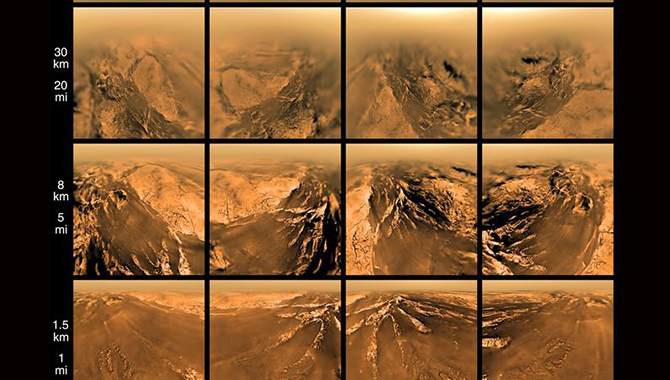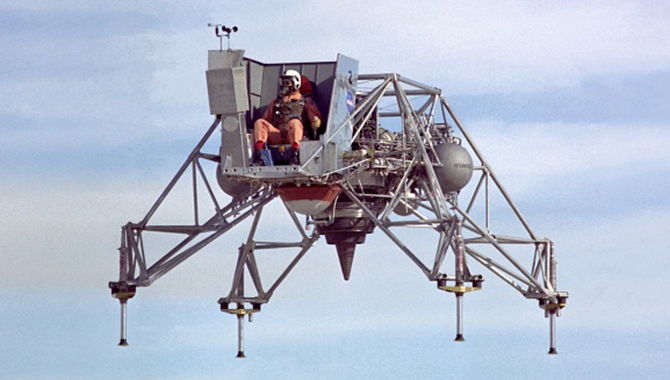
Images of Titan taken by Huygens at different altitudes as the probe descended toward the moon’s surface.
Photo Credit: ESA/NASA/JPL/University of Arizona
Ten years ago this month, the Huygens probe landed on Titan. But the multi-national mission was almost derailed by a language barrier—between machines.
The Huygens atmospheric entry probe left Cape Canaveral in October 1997 aboard the Cassini orbiter, headed for Saturn’s largest moon: Titan. The mission was an international effort from the start. The European Space Agency (ESA) developed the probe along with the communications equipment on Cassini that would allow the two spacecraft to exchange information once Huygens was deployed. Agenzia Spaziale Italiana, Italy’s space agency, provided additional communications systems, including Cassini’s high-gain antenna, a low-gain antenna, radar, and the radio science subsystem that would be used to transmit and decode data from the probe to the spacecraft. NASA contributed Cassini, which would deliver Huygens to Titan and then continue on to study Saturn and its moons. Altogether, more than a dozen nations were involved in the project, producing the most complex unmanned interplanetary craft yet constructed.
The plan for Huygens was straightforward. Once deployed, the probe would descend through Titan’s cloud-filled atmosphere, transmitting data as it went to Cassini—and through Cassini, to the world—before landing on the moon’s surface. The data from Huygens were of enormous interest as scientists believed learning more about Titan might shed light on Earth’s primordial atmosphere and early development.
But less than halfway through Cassini’s 6.7-year deep space journey, scientists at ESA and NASA realized there was a problem. The probe-to-orbiter radio relay link did not function as expected. Without it, the world would never learn Titan’s secrets from Huygens.
The communication system between Huygens and Cassini had not been fully tested before leaving Earth. Each part was carefully constructed, vetted, and assembled; but the system as a whole was never subjected to a comprehensive, real-world test. Raised as a concern while the spacecraft was still on the ground but dismissed, the issue peaked again while the orbiter was en-route to Saturn. This time, the agencies involved agreed to attempt a test.
The initial problem was how to test the system. They couldn’t test the radio link between Huygens and Cassini during flight; the orbiter and probe were connected by cable throughout the trip. They couldn’t test the radio link by sending a signal from Earth to Cassini’s receiver; that wouldn’t emulate the quality of the signal the probe would actually send. The probe’s signal would be subject to variability in both frequency and strength as Huygens and Cassini moved and atmospheric conditions changed.
Ultimately, ESA scientist Boris Smeds developed a test program that imitated the signal Huygens would transmit while descending to Titan’s surface. In February 2000, the test was conducted through the Deep Space Network (DPN): Smeds’ signal was transmitted to Cassini, which then returned the data back to Earth where it could be decoded and examined for accuracy.
The results were anything but accurate. While the signal was clear, much of the data was garbled. A multi-national task force gathered to solve the problem. Eventually, the anomaly was uncovered: under certain circumstances, an issue with the Huygens receiver on Cassini prohibited accurate decoding of data. The problem involved the Doppler effect. This effect causes a perceived shift in frequency for a sound wave that is produced by a moving source. Because both Cassini and Huygens would be in motion when the probe transmitted its data, their positions would affect the way the receiver collected and processed the data.
Even with the problem identified, a solution remained evasive. The simplest approach was to fix the receiver itself, but its firmware could not be updated. So the taskforce came up with a more daunting proposition: to alter the trajectory of Cassini so that its position relative to Huygens negated the problem. The spacecraft’s trajectory, however, had been designed years earlier to enable multiple flybys of Saturn and its moons. Changing it presented a major technical challenge that endangered Cassini’s overall mission. But with no other options and Huygens’ entire mission at risk, a new trajectory was designed that would send Cassini on three orbits around Saturn before deploying the probe instead of the originally planned two, using much of the spacecraft’s fuel reserve.
Solution in hand, the mission moved forward. Cassini reached Saturn in July 2004. Six months later the spacecraft jettisoned Huygens, sending it on its solo mission into space. The probe traveled for 21 days before entering Titan’s atmosphere on January 14, 2005.
Seven years after launch, Huygens became the first man-made craft to land on a moon in the outer solar system. During its 2.5-hour descent to Titan’s surface, the probe successfully transmitted data to Cassini—and Cassini’s receiver decoded the data correctly. Together, they lifted the veil on a cloud-shrouded world, revealing Earth-like mountains, seas, and dunes for all to see.
Watch a video about Huygens’ landing on Titan, including images from the probe.









